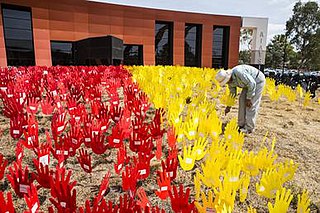This page is based on this
Wikipedia article Text is available under the
CC BY-SA 4.0 license; additional terms may apply.
Images, videos and audio are available under their respective licenses.

The Kabalbara also rendered Gabalbura and Gabulbarra, is an Australian aboriginal tribe of northern Queensland. No linguistic information has been recorded.
The Waljen are an indigenous people of Western Australia, in the Goldfields-Esperance area.
The Bailgu are an indigenous Australian people of the Pilbara region of Western Australia.
The Panyjima are an indigenous people of the Pilbara region of Western Australia.
The Wirdinja were an indigenous Australian people of Western Australia.
The Malgaru were an indigenous Australian people of Western Australia. They might have been a subgroup of the Wariangga.
The Ninanu were an indigenous Australian people of the Gascoyne region of Western Australia.
The Doolboong, also known as Duulngari, were an indigenous Australian people of the Northern Territory and northeast Western Australia.
The Mandjindja or Mantjintjarra are an indigenous Australian people of Western Australia.
The Binigura were an indigenous Australian people of the Pilbara region of Western Australia.
The Ngarlawongga, or more properly Ngarla, were an indigenous Australian people of the inland Mid West region of Western Australia. They are not to be confused with the Ngarla who live on the coast.
The Wardal were an indigenous Australian people of Western Australia.
The Tjalkadjara or Tjalkanti were an indigenous Australian tribe of Western Australia.
The Kalaako (Kalarko) were an indigenous Australian people of the Goldfields-Esperance region of Western Australia.
The Malngin were an indigenous Australian people of Western Australia. The Malngin language was a dialect of Gurindj.
The Laia were an indigenous Australian people of the state of Queensland.
The Ewamin or Agwamin were an indigenous Australian people of the state of Queensland.
The Iningai (Yiningayi) were an indigenous Australian people of the present-day Longreach Region in the state of Queensland.
The Wanyuru were an indigenous Australian people of the state of Queensland.
The Kongabula were an indigenous Australian people of the state of Queensland.







